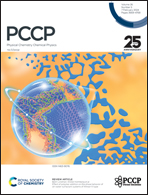Radiolytic evaluation of a new technetium redox control reagent for advanced used nuclear fuel separations†
Abstract
Technetium is a problematic radioisotope for used nuclear fuel (UNF) and subsequent waste management owing to its high environmental mobility and coextraction in reprocessing technologies as the pertechnetate anion (TcO4−). Consequently, several strategies are under development to control the transport of this radioisotope. A proposed approach is to use diaminoguanidine (DAG) for TcO4− and transuranic ion redox control. Although the initial DAG molecule is ultimately consumed in the redox process, its susceptibility to radiolysis is currently unknown under envisioned UNF reprocessing conditions, which is a critical knowledge gap for evaluating its overall suitability for this role. To this end, we report the impacts of steady-state gamma irradiation on the rate of DAG radiolysis in water, aqueous 2.0 M nitric acid (HNO3), and in a biphasic solvent system composed of aqueous 2.0 M HNO3 in contact with 1.5 M N,N-di-(2-ethylhexyl)isobutyramide (DEHiBA) dissolved in n-dodecane. Additionally, we report chemical kinetics for the reaction of DAG with key transients arising from electron pulse radiolysis, specifically the hydrated electron (eaq−), hydrogen atom (H˙), and hydroxyl (˙OH) and nitrate (NO3˙) radicals. The DAG molecule exhibited significant reactivity with the ˙OH and NO3˙ radicals, indicating that oxidation would be the predominant degradation pathway in radiation environments. This is consistent with its role as a reducing agent. Steady-state gamma irradiations demonstrated that DAG is readily degraded within a few hundred kilogray, the rate of which was found to increase upon going from water to HNO3 containing solutions and solvents systems. This was attributed to a thermal reaction between DAG and the predominant HNO3 radiolysis product, nitrous acid (HNO2), k(DAG + HNO2) = 5480 ± 85 M−1 s−1. Although no evidence was found for the radiolysis of DAG altering the radiation chemistry of the contacted DEHiBA/n-dodecane phase in the investigated biphasic system, the utility of DAG as a redox control reagent will likely be limited by significant competition with its degradation by HNO2.

- This article is part of the themed collection: Celebrating International Women’s day 2025: Women in physical chemistry


 Please wait while we load your content...
Please wait while we load your content...